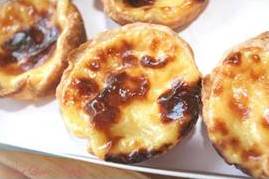Welcome to Tea, a virtual tribute to the art of having tea. As Henry James once said: “There are few hours in life more agreeable than the hour dedicated to the ceremony known as afternoon tea.
The British may have failed miserably in other culinary areas, but they excel in the tea ritual. Today’s treat is are the utterly delicious Portuguese Custard Tarts.
My Online Guide to the Tea Ritual
Many of you will have been to the UK for the Olympics and perhaps have lingered to looking for a chance to have “afternoon tea”. To help avoid disappointment (there is a difference between afternoon and high tea), I have created a handy guide to help you enjoy the experience: Downton Abbey Cooks Online Guide to Afternoon Tea. The guide includes:
- The history of Tea in England
- Tea Lingo
- The difference between Afternoon and High Tea
- Proper tea etiquette
The guide also includes tips and recipes to host your own tea party, perhaps to gather friends to watch your favourite Downton Abbey episode:
- How to make a proper cup of tea
- Sweet and Savoury tea recipes, including a great scone recipe you can adapt many ways.
- How to build a tea service on a budget.
Or you can purchase your own handbook, Relaxing Over Afternoon Tea from the Shop page.
Fun Food History: Portuguese Custard Tart
Angel food cake is one of my favourite summer desserts to make for family and company. It is light, low fat and loves to be dressed up with fresh fruit. Since a cake will use almost a dozen egg whites, the question became what to do with the yolks. In our household, it was to make lots of custard tarts, a classic English tea sweet which many European countries have adopted to make a variation of their own.
The story goes that the tart, called “pastel de nata”, was created in monasteries in the 18th century as one of many desserts which used egg yolks. A massive amount of egg whites were used for starching clothes (such as nuns’ habits) and in the process of making wine. I was horrified to discover how many calories each one had so with some experimentation I found a way to reduce the number of egg yolks required, and replace the cream with skim milk. It doesn’t help me use up lots of egg yolks but makes a healthier dessert, and besides, you can now buy pasteurized egg whites which I can use for my angel food cakes. There is still some fat, as can’t resist the puff pastry crust which makes the tart very easy to make, but this version cuts the calories by 2/3rds.
Low Fat Portuguese Custard Tarts (Pastel de Nata)
Super Easy Portuguese Custard Tarts (Pastel De Nata)
Ingredients
- 2 large egg yolks
- 1 large whole egg
- ½ cup caster sugar (or sugar substitute like Stevia)
- 2 tbsp. cornstarch
- 1 ¾ cup skim milk
- 2 tsp. vanilla extract
- 1 sheet puff pastry*
Instructions
Make the custard
- Put the egg yolks, sugar and cornstarch in a pan and whisk together. Gradually whisk in the milk until smooth.
- Place the pan over a medium heat and cook, stirring, until the mixture thickens and comes to the boil. Remove from the heat and stir in the vanilla extract. Transfer the custard to a bowl, cover the surface with cling film to prevent a skin forming and leave to cool.
Make the tarts
- Lightly grease a 12 tray muffin pan.
- Preheat the oven to 400 F degrees 200 C.
- Use pre-rolled pastry, or roll out puff pastry to thin rectangle. Roll up the pastry tightly from the short end and cut the pastry log into 12 rounds, about 1/2 inch thick. Lay each pastry round on a lightly floured surface and use a rolling pin to roll out or press with the palm of your hand to create a really thin circle which will fit into the muffin tray.
- Press the pastry rounds into the muffin tin.
Assemble and bake the tarts
- Spoon the cooled custard into the pastry cases and bake for 20-25 minutes, or until the pastry and custard are golden. I will sometimes turn on the broiler for a few minutes to get a few extra burn marks which is a distinct feature of this tart.
- Leave the tarts in the tin for 5 minutes, then transfer to a wire rack to cool completely.
